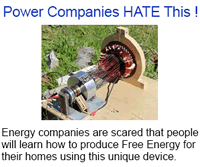Don’t Jump on The Thorium Bandwagon – It’s Not Green, Not Viable, And Not The Answer To Our Energy Problems
![]() Kelley Bergman, Prevent Disease
Kelley Bergman, Prevent Disease
Waking Times
They say it can power a vehicle to run cleanly for 100 years with one fueling. They say the technology is safe, intrinsically proven and produces no high-level waste. Scientists all over the world are chiming in on thorium as the next viable and alternative energy source to uranium. However, thorium still represents a very large threat to the planet whose problems over current nuclear systems exist only in details. It is not eco-friendly by any stretch of the imagination, although it is being promoted as such to nations around the world. It’s not renewable, green or clean and definitely not the answer to the world’s energy crisis as scientists around the world are deceptively claiming.
Due to its extreme density, thorium is being highlighted for its potential to produce tremendous amounts of heat. Many companies have been experimenting with small bits of thorium, creating lasers that heat water, producing steam which can power a mini turbines. According to CEO Charles Stevens from Laser Power Systems (LPS) from Connecticut, USA,, just one gram of the substance yields more energy than 7,396 gallons (28,000 L) of gasoline and 8 grams would power the typical car for a century.
The idea of using thorium is not new. In 2009, Loren Kulesus designed the Cadillac World Thorium Fuel Concept Car.
Dozens of other companies are investing millions and jumping on the thorium bandwagon without any foresight or wisdom into the long-term devasting effects of another nuclear-based problem.
Thorium is now being heavily promoted by the nuclear industry and various lobbies. Its mining is based on exploitation of workers forced to work with bare hands and contamination, sacking and devastation of territories.
What Is Thorium?
Thorium is a radioactive chemical element. It produces a radioactive gas, radon-220, as one of its decay products. Secondary decay products of thorium include radium and actinium. In nature, virtually all thorium is found as thorium-232, which undergoes alpha decay with a half-life of about 14.05 billion years.
As far as nations go, Canada, China, Germany, India, the Netherlands, the United Kingdom and the United States have all experimented with using thorium as a substitute nuclear fuel in nuclear reactors.
Highly Carcinogenic Causing Defomities
 Besides being radioactive, thorium is also a highly carcinogenic heavy metal used in military targeting systems and has been found in honey, milk, and other areas of the food chain where the military has been testing thorium such as Sardinia.
Besides being radioactive, thorium is also a highly carcinogenic heavy metal used in military targeting systems and has been found in honey, milk, and other areas of the food chain where the military has been testing thorium such as Sardinia.
Sardinia is the second largest island in the Mediterranean Sea — a paradise with diverse wildlife and beautiful beaches. For over 50 years Sardinia has been used by militaries and arms manufacturers as a testing ground for bullets, bombs, missiles and drones and dangerous chemicals.
Sardinia is the victim of weapons manufacturers, polluting military activities and a political system that cares about power and money over the health of people and the environment. An epidemic of cancers and birth defects is now evident in this region through their soil, air, food and water contaminated with heavy metals, jet fuel and other poisons.
The nuclear physicist Evandro Lodi Rizzini of Brescia University and CERN (European Organization for Nuclear Research) found elevated levels of radioactive thorium 232 and cerium (proving that the thorium was man-made) in the tissues of 15 of 18 bodies in the Quirra area of Sardinia where they died of cancer between 1995 and 2000.
On March 24, 2012, prosecutor Domenico Fiordalisi in Lanusei, Sardinia, indicted twenty people on charges of “willful omission of precautions against injury and aggravated disasters or because they falsely certified the absence of pollution with the aim to “hide the environmental disaster.” The documents from Fiordalisi’s investigation have now been turned over to a tribunal for prosecution.
Fiordalisi opened his investigation when he learned the results of cancer research in the Quirra area. In the last 10 years, 65 percent of shepherds were diagnosed with leukemia, lymphomas and autoimmune diseases. He suspected that the materials used in the polygon contaminated soils, pastures, water and air poisoning people, plants and animals as a consequence.
On 8 May 2012, Fiordalisi reported to the Parliamentary Committee of Senators’ Inquiry on DU the results of these investigations led by him. He detailed how chromium, tungsten and thorium and of the extreme danger of the alpha particles generated by this substance.
He explained that thorium is much more harmful than depleted uranium, and that the area of the polygon of Quirra was completly impregnated. This substance has found its way into cheese, worms, mushrooms, sheperds and animals: pigs born with six legs and lambs with a single large eye. He stated that the 1187 milan missles that were launched between 1983 and 1999 which, in the opinion of the nuclear physicist Evandro Lodi Rizzini were responsible for an epidemic of cancers and lymphomas in the military due to the release of radioactive substances.
Dr. Rizzini said, “One micro-gram, that is, one millionth of a gram is sufficient to kill a person. It causes a rise in atomic disintegrations; with a production of 2000 alpha rays a day, nuclear radiation is most damaging.”
The organizations International Coalition to Ban Uranium Weapons and Mother Earth have good information about depleted uranium.
“With uranium-based nuclear power continuing its decades-long economic collapse, it’s awfully late to be thinking of developing a whole new fuel cycle whose problems differ only in detail from current versions.”
Amory Lovins, Rocky Mountain Institute, March 2009.
THORIUM CLAIMS AND REALITIES
Numerous claims of advantages for thorium as a nuclear fuel and for LFTR (Liquid Fluoride Thorium Reactor) design have been made over conventional solid fuel reactors.
Nuclear Weapons Proliferation
Claim: thorium reactors do not produce plutonium, and so create little or no proliferation hazard.
Response: a LFTR could be adapted to produce plutonium of a high purity well above normal weapons-grade, presenting a major proliferation hazard. Beyond that, the main proliferation hazards arise from:
- the need for fissile material (plutonium or uranium) to initiate the thorium fuel cycle, which could be diverted, and
- the production of fissile uranium 233U.Claim: the fissile uranium (233U) produced by thorium reactors is not “weaponisable” owing to the presence of highly radiotoxic 232U as a contaminant. Response: 233U was successfully used in a 1955 bomb test in the Nevada Desert under the USA’s Operation Teapot and so is clearly weaponisable notwithstanding any 232U present.
Claim: LFTRs are intrinsically safe, because the reactor operates at low pressure and is and incapable of melting down.
Response: the design of molten salt reactors does indeed mitigate against reactor meltdown and explosion. However, in an LFTR the main danger has been shifted from the reactor to the on-site continuous fuel reprocessing operation — a high temperature process involving highly hazardous, explosive and intensely radioactive materials. A further serious hazard lies in the potential failure of the materials used for reactor and fuel containment in a highly corrosive chemical environment, under intense neutron and other radiation.
State of Technology
Claim: the technology is already proven.
Response: important elements of the LFTR technology were proven during the 1970s Molten Salt Breeder Reactor (MSBR) at Oak Ridge National Laboratory. However, this was a small research reactor rated at just 7MW and there are huge technical and engineering challenges in scaling up this experimental design to make a ‘production’ reactor. Specific challenges include:
- developing materials that can both resist corrosion by liquid fluoride salts including diverse fission products, and withstand decades of intense neutron radiation;
- scaling up fuel reprocessing techniques to deal safely and reliably with large volumes of highly radioactive material at very high temperature;
- keeping radioactive releases from the reprocessing operation to an acceptably low level;
- achieving a full understanding of the thorium fuel cycle.
Nuclear Waste
Claim: LFTRs produce far less nuclear waste than conventional solid fuel reactors.
Response: LFTRs are theoretically capable of a high fuel burn-up rate, but while this may indeed reduce the volume of waste, the waste is more radioactive due to the higher volume of radioactive fission products. The continuous fuel reprocessing that is characteristic of LFTRs will also produce hazardous chemical and radioactive waste streams, and releases to the environment will be unavoidable.
Claim: Liquid fluoride thorium reactors generate no high-level waste material.
Response: This claim, although made in the report from the House of Lords, has no basis in fact. High-level waste is an unavoidable product of nuclear fission. Spent fuel from any LFTR will be intensely radioactive and constitute high level waste. The reactor itself, at the end of its lifetime, will constitute high level waste.
Claim: the waste from LFTRs contains very few long-lived isotopes, in particular transuranic actinides such as plutonium.
Response: the thorium fuel cycle does indeed produce very low volumes of plutonium and other long-lived actinides so long as only thorium and 233U are used as fuel. However, the waste contains many radioactive fission products and will remain dangerous for many hundreds of years. A particular hazard is the production of 232U, with its highly radio-toxic decay chain.
Claim: LFTRs can ‘burn up’ high level waste from conventional nuclear reactors, and stockpiles of plutonium.
Response: if LFTRs are used to ‘burn up’ waste from conventional reactors, their fuel now comprises 238U, 235U, 239Pu, 240Pu and other actinides. Operated in this way, what is now a mixed-fuel molten salt reactor will breed plutonium (from 238U) and other long lived actinides, perpetuating the plutonium cycle.
What Can You Do?
Spread the word about Sardinia. More information is available at http://docs.google.com/open?id=0B-F67wRS5N7sR3hYMl9id0xkNWs where the original 7500-word research document is stored.
Contact your congressional representatives and demand the closure of the Sardinia NATO bases.
Do we really want another polluting energy source with high-level waste which is non-renewable and highly carcinogenic? Before jumping on the thorium bandwagon, please share this information, do your own research and think twice before spreading the hundreds of myths (not facts) about this very dangerous alternative to uranium.
About the Author
Kelley Bergman is a media consultant, critic and geopolitical investigator. She has worked as a journalist and writer, specializing in geostrategic issues around the globe.
Sources:
nuclearfreeplanet.org
nonukes.it
industrytap.com
envirosagainstwar.org
~~ Help Waking Times to raise the vibration by sharing this article with the buttons below…

